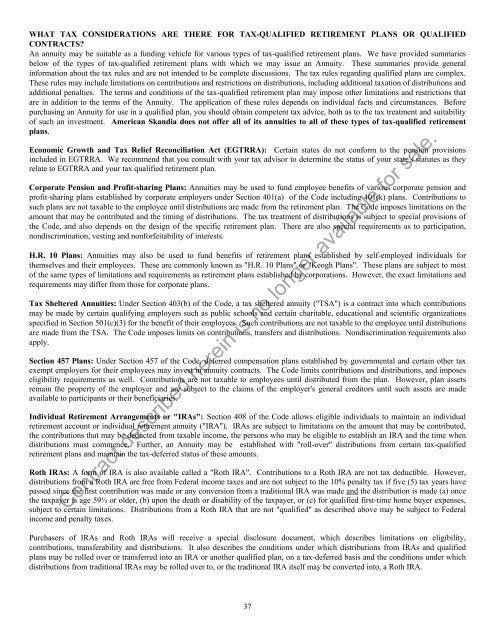Stagecoach Flex - Prudential Annuities
Stagecoach Flex - Prudential Annuities
Stagecoach Flex - Prudential Annuities
Create successful ePaper yourself
Turn your PDF publications into a flip-book with our unique Google optimized e-Paper software.
WHAT TAX CONSIDERATIONS ARE THERE FOR TAX-QUALIFIED RETIREMENT PLANS OR QUALIFIEDCONTRACTS?An annuity may be suitable as a funding vehicle for various types of tax-qualified retirement plans. We have provided summariesbelow of the types of tax-qualified retirement plans with which we may issue an Annuity. These summaries provide generalinformation about the tax rules and are not intended to be complete discussions. The tax rules regarding qualified plans are complex.These rules may include limitations on contributions and restrictions on distributions, including additional taxation of distributions andadditional penalties. The terms and conditions of the tax-qualified retirement plan may impose other limitations and restrictions thatare in addition to the terms of the Annuity. The application of these rules depends on individual facts and circumstances. Beforepurchasing an Annuity for use in a qualified plan, you should obtain competent tax advice, both as to the tax treatment and suitabilityof such an investment. American Skandia does not offer all of its annuities to all of these types of tax-qualified retirementplans.Economic Growth and Tax Relief Reconciliation Act (EGTRRA): Certain states do not conform to the pension provisionsincluded in EGTRRA. We recommend that you consult with your tax advisor to determine the status of your state's statutes as theyrelate to EGTRRA and your tax qualified retirement plan.Corporate Pension and Profit-sharing Plans: <strong>Annuities</strong> may be used to fund employee benefits of various corporate pension andprofit-sharing plans established by corporate employers under Section 401(a) of the Code including 401(k) plans. Contributions tosuch plans are not taxable to the employee until distributions are made from the retirement plan. The Code imposes limitations on theamount that may be contributed and the timing of distributions. The tax treatment of distributions is subject to special provisions ofthe Code, and also depends on the design of the specific retirement plan. There are also special requirements as to participation,nondiscrimination, vesting and nonforfeitability of interests.H.R. 10 Plans: <strong>Annuities</strong> may also be used to fund benefits of retirement plans established by self-employed individuals forthemselves and their employees. These are commonly known as "H.R. 10 Plans" or "Keogh Plans". These plans are subject to mostof the same types of limitations and requirements as retirement plans established by corporations. However, the exact limitations andrequirements may differ from those for corporate plans.Tax Sheltered <strong>Annuities</strong>: Under Section 403(b) of the Code, a tax sheltered annuity ("TSA") is a contract into which contributionsmay be made by certain qualifying employers such as public schools and certain charitable, educational and scientific organizationsspecified in Section 501(c)(3) for the benefit of their employees. Such contributions are not taxable to the employee until distributionsare made from the TSA. The Code imposes limits on contributions, transfers and distributions. Nondiscrimination requirements alsoapply.Section 457 Plans: Under Section 457 of the Code, deferred compensation plans established by governmental and certain other taxexempt employers for their employees may invest in annuity contracts. The Code limits contributions and distributions, and imposeseligibility requirements as well. Contributions are not taxable to employees until distributed from the plan. However, plan assetsremain the property of the employer and are subject to the claims of the employer's general creditors until such assets are madeavailable to participants or their beneficiaries.Individual Retirement Arrangements or "IRAs": Section 408 of the Code allows eligible individuals to maintain an individualretirement account or individual retirement annuity ("IRA"). IRAs are subject to limitations on the amount that may be contributed,the contributions that may be deducted from taxable income, the persons who may be eligible to establish an IRA and the time whendistributions must commence. Further, an Annuity may be established with "roll-over" distributions from certain tax-qualifiedretirement plans and maintain the tax-deferred status of these amounts.Roth IRAs: A form of IRA is also available called a "Roth IRA". Contributions to a Roth IRA are not tax deductible. However,distributions from a Roth IRA are free from Federal income taxes and are not subject to the 10% penalty tax if five (5) tax years havepassed since the first contribution was made or any conversion from a traditional IRA was made and the distribution is made (a) oncethe taxpayer is age 59½ or older, (b) upon the death or disability of the taxpayer, or (c) for qualified first-time home buyer expenses,subject to certain limitations. Distributions from a Roth IRA that are not "qualified" as described above may be subject to Federalincome and penalty taxes.Contract described herein is no longer available for sale.Purchasers of IRAs and Roth IRAs will receive a special disclosure document, which describes limitations on eligibility,contributions, transferability and distributions. It also describes the conditions under which distributions from IRAs and qualifiedplans may be rolled over or transferred into an IRA or another qualified plan, on a tax-deferred basis and the conditions under whichdistributions from traditional IRAs may be rolled over to, or the traditional IRA itself may be converted into, a Roth IRA.37
















